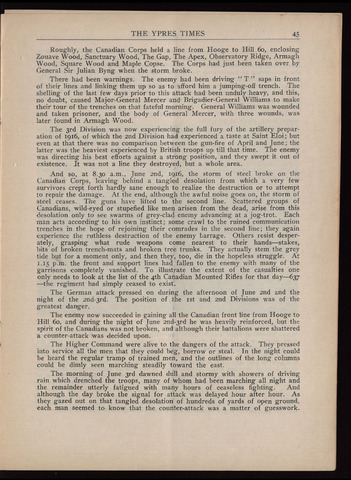THE YPRES TIMES
45
Roughly, the Canadian Corps held a line from Hooge to Hill 60, enclosing
Zouave Wood, Sanctuary Wood, The Gap, The Apex, Observatory Ridge, Armagh
Wood, Square Wood and Maple Copse. The Corps had just been taken over by
General Sir Julian Byng when the storm broke.
There had been warnings. The enemy had been driving T saps in front
of their lines and linking them up so as to afford him a jumping-off trench. The
shelling of the last few days prior to this attack had been unduly heavy, and this,
no doubt, caused Major-General Mercer and1 Brigadier-General Williams to make
their tour of the trenches on that fateful morning. General Williams was wounded
and taken prisoner, and the body of General Mercer, with three wounds, was
later found in Armagh Wood.
The 3rd Division was now experiencing the full fury of the artillery prepar
ation of 1916, of which the 2nd Division had experienced a taste at Saint Eloibut
even at that there was no comparison between .the gun-fire of April and June; the
latter was the heaviest experienced by British troops up till that time. The enemy
was directing his best efforts against a strong position, and they swept it out of
existence. It was not a line they destroyed, but a whole area.
And so, at 8.30 a.m., June 2nd, 1916, the storm of steel broke on the
Canadian Corps, leaving behind a tangled desolation from which a very few
survivors crept forth hardly sane enough to realize the destruction or to attempt
to repair the damage. At the end, although the awful noise goes on, the storm of
steel ceases. The guns have lifted to the second line. Scattered groups of
Canadians, wild-eyed or stupefied like men arisen from the dead, arise from this
desolation only to see swarms of grey-clad enemy advancing at a jog-trot. Each
man acts according to his own instinct; some crawl to the ruined communication
trenches in the hope of rejoining their comrades in the second line; they again
experience the ruthless destruction of the enemy barrage. Others resist desper
ately, grasping what rude weapons come nearest to their handsstakes,
bits of broken trench-mats and broken tree trunks. They actually stem the grey
tide but for a moment only, and then they, too, die in the hopeless struggle. At
1.15 p.m. the front and support lines had fallen to the enemy with many of the
garrisons completely vanished. To illustrate the extent of the casualties one
only needs to look at the list of the 4th Canadian Mounted Rifles for that day637
the regiment had simply ceased to exist.
The German attack pressed on during the afternoon of June 2nd and the
night of the 2nd-3rd. The position of .the 1st and 2nd Divisions was of the
greatest danger.
The enemy now succeeded in gaining all the Canadian front line from Hooge to
Hill 60, and during the night of June 2nd-3rd he was heavily reinforced, but the
spirit of the Canadians was not broken, and although their battalions were shattered
a counter-attack was decided upon.
The Higher Command were alive to the dangers of the attack. They pressed
into service all the men that they could beg, borrow or steal. In the night could
be heard the regular tramp of trained men, and the outlines of the long columns
could be dimly seen marching steadily toward the east.
The morning of June 3rd dawned dull and stormy with showers of driving
rain which drenched the troops, many of whom had been marching all night and
the remainder utterly fatigued with many hours of ceaseless fighting. And
although the day broke the signal for attack was delayed hour after hour. As
they gazed out on that tangled desolation of hundreds of yards of open ground,
each man seemed to know that the counter-attack was a matter of guesswork.

